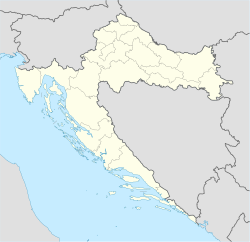Top Qs
Timeline
Chat
Perspective
Perjasica
Village in Croatia From Wikipedia, the free encyclopedia
Remove ads
Perjasica is a village in central Croatia, in the municipality of Barilović, Karlovac County. It is alternately known as Gornja Perjasica.[3] The village suffered large losses to property and life during World War II and the Croatian War of Independence. Inhabitants returning to the region after the War of Independence faced bureaucratic and legal barriers, leading to a steep decline in post-war population. Limited reinvestment in this area after the war has resulted in few operational public services, with no public transportation options, irregular roads frequently made impassable by snow, and limited medical access.[4]
Remove ads
History
Summarize
Perspective
Beginning on 5 July 1942, the Battle of Primišlje took place. 500 Partisans from Perjasica and 700 from Tobolić laid siege to Primišlje. This included the 1st and 2nd brigade of the First Kordun Detachment and the 1st and 4th brigade of the 3rd battalion of the Second Kordun Detachment. On the 12th, 2 Ustaša companies came to their rescue.[5]
Beginning on the 19th, the Battle of Tržić took place between Kamenica and Tržić Tounjski. An army of Partisans of the Second Kordun Detachment carried out an attack from Tobolić with 700, Popovići by the Vrelo Mrežnice and Perjasica with 500, and Drežnica with 250, on the pontoon bridge across the Mrežnica by Juzbašići, with the goal of destroying the bridge and disarming the Croatian forces in Tržić. The bridge was guarded by the 3rd Regiment of the Second Domobran Division. Croatia called in reinforcements from Karlovac, which failed to penetrate to Juzbašići. Battles continued with 6 waves of Domobran attacks until the 23rd, when the Partisan army took Tržić and disarmed their opponents, taking captives and transporting them to Tobolić, including Ivan Stipac, Domobran commander in Ogulin. Across the river, the Domobrani of Primišlje retreated to Slunj. After Tržić was taken, the Partisans dismantled the pontoon bridge and destroyed the railway bridge (under repair at the time). The village was completely burned. Because the area was in Zone III, the Italians could only offer artillery support, which they did while the Partisans took Kamenica.[6]
Remove ads
Demographics
In 1890, the obćina of Perjasica (court at Perjasica), with an area of 111 square kilometres (43 sq mi), belonged to the kotar of Vojnić (Vojnić electoral district but Krnjak court) in the županija of Modruš-Rieka (Ogulin court and financial board). There were 686 houses, with a population of 3945 (lowest in Vojnić kotar): 1981 male and 1964 female. All were Croatian or Serbian speakers. The majority were Eastern Orthodox, but 102 were Catholic. Its 29 villages were divided for taxation purposes into 6 porezne obćine, under the Slunj office.[7]: vi, vii [8]: xxx, xxxi
According to the 2011 census,[9] the village of Perjasica has 17 inhabitants. This represents 14.66% of its pre-war population according to the 1991 census.
The 1991 census[10] recorded that 83.62% of the village population were ethnic Serbs (97/116), 7.76% were ethic Croats (9/116) and 8.62% were of other ethnic origin (10/116).
Remove ads
Governance
On 1 January 1893, Mateško Selo was annexed by Generalski Stol obćina, having formerly been under Perjasica obćina.[12]: 209
Infrastructure
In 1913, there were 6 gendarmeries in Vojnić kotar: Barilović, Krnjak, Krstinja, Perjasica, Vojnić and Vukmanić.[13]
Sights
- Memorial to the victims of fascism and fallen partisans[14]
Notable natives and residents
This section is empty. You can help by adding to it. (February 2018) |
References
Bibliography
Wikiwand - on
Seamless Wikipedia browsing. On steroids.
Remove ads
